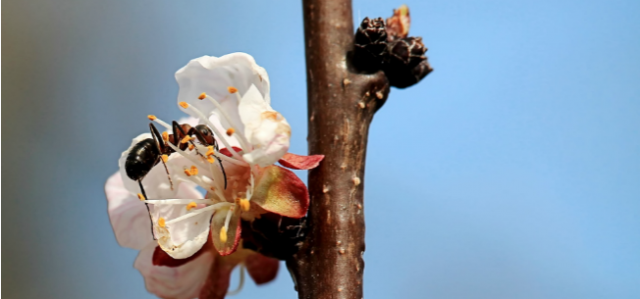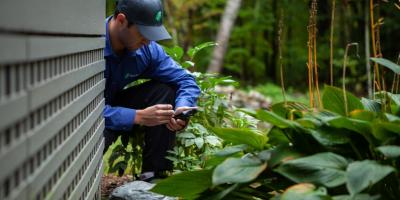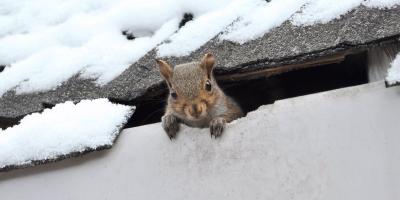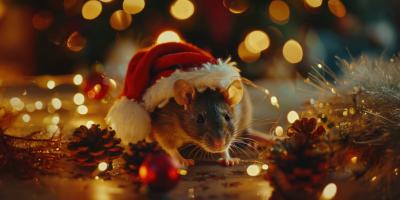Spring Invaders: 15 Wildlife Pests You May Face In The Springtime

Ahh, springtime - the weather’s nice, the sun is shining, and it’s finally time to get outside and enjoy the fresh air. Unfortunately for us, however, that same feeling is shared by all of those pesky springtime pests, and that means there’s no season that calls for more vigilance against pests and wildlife than spring.
Whether you live in the heart of downtown or way off in the country, there are a number of common springtime pests that annually affect just about every homeowner. Here’s a look at some of the most common, and some tips on how to keep them from ruining your enjoyment of all that spring sunshine.
1. Ants
There may be no spring pest more persistently frustrating for the average homeowner than ants. With high numbers on their side and a serious craving for sugar, sweets, salt, and just about any food or water they can find, ants can seem relentless in their efforts to invade throughout the spring and summer. As you’re taking on your spring cleaning, be sure to close up any holes or tiny cracks where ants could be entering, and keep surfaces free of crumbs or pools of water to keep the temptation away.
2. Flies
Warm weather means one thing here in New England: it’s time to fire up the barbecue. But whether you’re grilling outside on the patio or preparing a spread for friends in the kitchen, flies can pose a serious problem for your spring get-togethers. To minimize the likelihood of fly invasions, be sure to keep trash areas and food prep surfaces clean, and to make sure screens on your doors and windows are in good shape.
3. Spiders
Spring cleaning is an important job, but digging through the garage or way into the back of the closet can reveal some pretty terrifying sights. We’re talking about spiders, their webs, and whatever they may have caught for dinner. Don’t let them get cozy - be sure to check for spiders in favorite hiding spots like room corners, cardboard boxes, underneath furniture, and in and around outdoor equipment.
4. Mice
It’s often assumed that once the weather warms up and life blooms, mice will leave the attics and basements they’ve been hiding in all winter in favor of the outdoors. But while some mice may venture outside to enjoy the spring, few will actually leave a comfy nest once they’ve found it. If they’re settled in your home, don’t expect them to leave on their own - be sure to check attics, basements, crawl spaces, and around your baseboards for signs of mice, and contact a pet professional for help getting every last one.
5. Bees
April showers may bring May flowers, but May flowers inevitably bring one major springtime pest: bees. As the weather warms and more pollen is available for the collecting, bee colonies will swell in size and establish a secure nesting site to last through the summer. But although bees can be a nuisance, they’re critically important to the local ecosystem. That’s why, if bees must be removed or if they’ve begun to swarm, it’s always recommended to contact a professional who can safely relocate the bee colony to a more appropriate location.
6. Ticks
As animals of all sizes wake from hibernation and get down to raising young in spring, they’re moving around and searching for food - and picking up plenty of ticks in the process. From deer bringing ticks through the woods to pets picking up ticks as they roll around outside, it only takes a brief contact for ticks to make the jump onto humans, causing irritation and spreading Lyme disease along the way. A robust tick prevention program from an experienced tick specialist can help reduce your tick problem and keep your family (and pets) safe through the spring.
7. Bats
In New England, springtime also brings with it the return of bats. Whether on their way back North from a migration or just waking up from a long winter’s hibernation, bats enter spring looking to start colonies wherever is most suitable. Barns, garages, and other rural buildings can often attract roosting bats, while in suburban areas attics tend to present the perfect nesting spot for single females or small groups. Because bats can be dangerous, if you suspect a bat may be in your home or property you should contact a wildlife specialist to safely extract and relocate the colony.
8. Squirrels
Winter is over, hibernation is finished, and squirrels are awake and looking for food - and they can’t always find all the acorns they left buried last fall. That’s why these pesky rodents have been known to dig through trash, climb up bird feeders, and even enter houses, sheds, and garages looking for warmth and shelter. If you suspect a squirrel may be getting comfortable in your space, contact a pest management professional to safely remove the squirrel and bring it back to the outdoors.
9. Termites
Long known as an annual headache for homeowners all across the country, termites can actually pose one of the biggest threats of all springtime pests. Whether it’s taking down your favorite tree or doing long-term damage to your house itself, a termite infestation is one pest problem you can’t ignore. If you notice the telltale signs of termites in your space, contact a pest management professional early and take care of the problem before it spreads out of control.
10. Mosquitoes
Few feelings beat the fun of fresh air and a warm fire as the sun sets on a warm spring day - a memorable experience quickly spoiled by annoying and persistent mosquitoes. As temperatures warm and snowmelt pools into springtime ponds and standing water, mosquitoes begin to hatch and start looking for food. If you experience particularly bad mosquito issues in your outdoor space, a pest professional can help mitigate the issue and offer advice for how to keep the mosquitoes to a minimum moving forward.
11. Wasps
Old wasp nests, left from last year, are generally not much of a problem - the emerging queens in spring will likely look for new places to nest. However, if wasps have nested in the walls of your home, it is possible that a new nest could start up in the same spot. Be sure to caulk up any cracks or holes on your home’s exterior where wasps could work their way in, and work to seal off prime nesting areas from access throughout the summer. If you do notice wasps setting up shop, contact a pest professional to help remove and seclude wasps moving forward.
12. Moths
Spring is prime time for moths to do their worst damage. Whether it’s clothes moths making holes in your favorite sweaters or gypsy moths munching through your favorite trees in the backyard, it’s actually the larvae - not the adult moths themselves - that leave the most damage behind, and they hatch in early spring. If you notice small larvae on your fabrics or on tree leaves, contact a moth removal expert to stop the infestation before they get the chance to do real damage.
13. Skunks
For skunks just waking from hibernation, spring is prime time to get started on raising young. Most skunks will give birth to their first litter of the year in mid- to late-spring, and during that time they may be more defensive of their young. If you encounter a skunk on your property (or if a pet has an unfortunate run-in), contact a wildlife specialist to remove or exclude the skunk and its young before they settle in for good.
14. Raccoons
Like skunks, raccoons tend to be most active right around April and May, when their first litter of kits arrives and mothers are out looking for food. This is when raccoons will be out on the prowl for loose trash cans, food left out for the taking, and a secluded shelter to raise and protect their young. All too often, this means homeowners find themselves dealing with tipped over trash cans in the morning, or finding a raccoon family nested under porches or in barns and sheds. A pest management professional can help remove raccoons who’ve built a nest, and offer advice on how to keep them away moving forward.
15. Snakes
They say St. Patrick drove out the snakes, and judging by the timing of St, Patrick’s Day we’d say he got on it at just the right time. Early- to mid-spring is prime time for snakes to emerge from hibernation and get started on laying eggs, and this is when they’ll be looking to set up nests in wood piles, under porches, and just about anywhere they can stay in shade and out of sight. A wildlife professional can help identify and safely remove snakes before they or their young get too comfortable.
Don’t Let Wildlife Prevent You From Enjoying Spring
Springtime is an exciting time to get outside and enjoy the warm weather - but nothing holds up the fun of the season quite like a wildlife or pest problem. If you’re looking forward to spring but you’re worried about keeping pests away, get in touch and we’ll identify solutions just for you - that way, you can charge into spring with nothing but the sunshine waiting to greet you.



